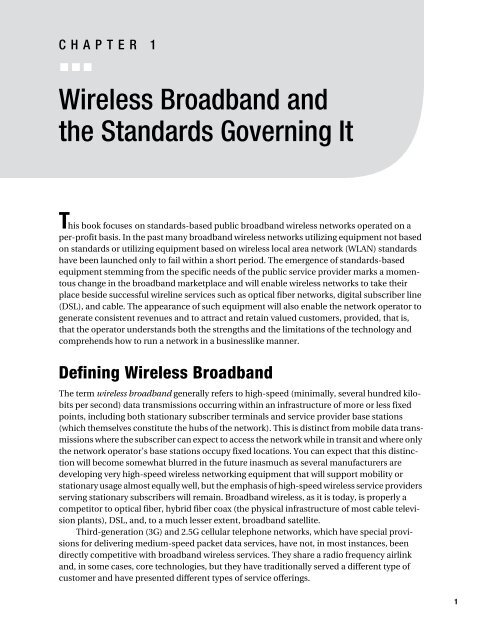WiMax Operator's Manual
WiMax Operator's Manual
WiMax Operator's Manual
Create successful ePaper yourself
Turn your PDF publications into a flip-book with our unique Google optimized e-Paper software.
CHAPTER 1<br />
■ ■ ■<br />
Wireless Broadband and<br />
the Standards Governing It<br />
This book focuses on standards-based public broadband wireless networks operated on a<br />
per-profit basis. In the past many broadband wireless networks utilizing equipment not based<br />
on standards or utilizing equipment based on wireless local area network (WLAN) standards<br />
have been launched only to fail within a short period. The emergence of standards-based<br />
equipment stemming from the specific needs of the public service provider marks a momentous<br />
change in the broadband marketplace and will enable wireless networks to take their<br />
place beside successful wireline services such as optical fiber networks, digital subscriber line<br />
(DSL), and cable. The appearance of such equipment will also enable the network operator to<br />
generate consistent revenues and to attract and retain valued customers, provided, that is,<br />
that the operator understands both the strengths and the limitations of the technology and<br />
comprehends how to run a network in a businesslike manner.<br />
Defining Wireless Broadband<br />
The term wireless broadband generally refers to high-speed (minimally, several hundred kilobits<br />
per second) data transmissions occurring within an infrastructure of more or less fixed<br />
points, including both stationary subscriber terminals and service provider base stations<br />
(which themselves constitute the hubs of the network). This is distinct from mobile data transmissions<br />
where the subscriber can expect to access the network while in transit and where only<br />
the network operator’s base stations occupy fixed locations. You can expect that this distinction<br />
will become somewhat blurred in the future inasmuch as several manufacturers are<br />
developing very high-speed wireless networking equipment that will support mobility or<br />
stationary usage almost equally well, but the emphasis of high-speed wireless service providers<br />
serving stationary subscribers will remain. Broadband wireless, as it is today, is properly a<br />
competitor to optical fiber, hybrid fiber coax (the physical infrastructure of most cable television<br />
plants), DSL, and, to a much lesser extent, broadband satellite.<br />
Third-generation (3G) and 2.5G cellular telephone networks, which have special provisions<br />
for delivering medium-speed packet data services, have not, in most instances, been<br />
directly competitive with broadband wireless services. They share a radio frequency airlink<br />
and, in some cases, core technologies, but they have traditionally served a different type of<br />
customer and have presented different types of service offerings.<br />
1
















